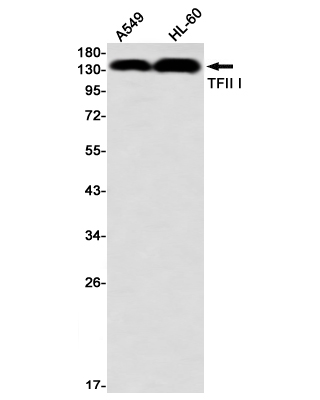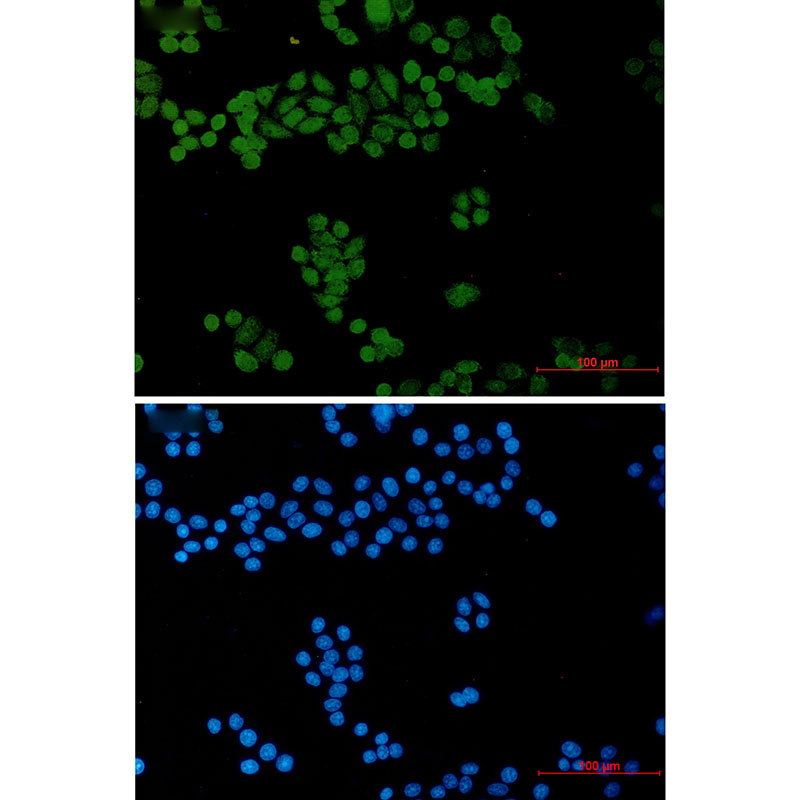


| WB | 1/500-1/1000 | Human,Mouse,Rat |
| IF | 咨询技术 | Human,Mouse,Rat |
| IHC | 1/50-1/100 | Human,Mouse,Rat |
| ICC | 1/50-1/200 | Human,Mouse,Rat |
| FCM | 咨询技术 | Human,Mouse,Rat |
| Elisa | 咨询技术 | Human,Mouse,Rat |
| Aliases | GTF2I; BAP135; WBSCR6; General transcription factor II-I; GTFII-I; TFII-I; Bruton tyrosine kinase-associated protein 135; BAP-135; BTK-associated protein 135; SRF-Phox1-interacting protein; SPIN; Williams-Beuren syndrome chromosomal region |
| Entrez GeneID | 2969 |
| WB Predicted band size | Calculated MW: 112 kDa; Observed MW: 135,138 kDa |
| Host/Isotype | Rabbit IgG |
| Antibody Type | Primary antibody |
| Storage | Store at 4°C short term. Aliquot and store at -20°C long term. Avoid freeze/thaw cycles. |
| Species Reactivity | Human |
| Immunogen | A synthetic peptide of human TFII I |
| Formulation | Purified antibody in TBS with 0.05% sodium azide,0.05%BSA and 50% glycerol. |
+ +
以下是关于General Transcription Factor II I(TFII-I)抗体的参考文献示例,按文献名称、作者及摘要内容简要概括:
1. **文献名称**: "TFII-I: A Multifaceted Transcription Factor in Development and Disease"
**作者**: Roy, A. L.
**摘要**: 综述了TFII-I的结构、功能及其在基因转录调控中的作用,提及特异性抗体的开发用于研究其亚细胞定位及与DNA结合活性的关联。
2. **文献名称**: "Phosphorylation of TFII-I Modulates Its Interaction with RNA Polymerase II"
**作者**: Cheriyath, L., et al.
**摘要**: 研究TFII-I的磷酸化修饰对其功能的影响,通过Western blot和免疫沉淀技术(使用TFII-I抗体)验证其与RNA聚合酶II的相互作用。
3. **文献名称**: "TFII-I Regulates Cell Cycle Progression via Chromatin Remodeling Complexes"
**作者**: Hakre, S., et al.
**摘要**: 利用TFII-I抗体进行ChIP-seq和免疫荧光实验,揭示其在细胞周期调控中通过染色质重塑复合物影响靶基因表达。
4. **文献名称**: "Role of TFII-I in B Cell Receptor Signaling"
**作者**: Herrera, J. E., et al.
**摘要**: 通过TFII-I抗体阻断实验,证明其在B细胞受体信号转导中调控下游基因转录的功能机制。
这些文献涵盖了抗体的应用场景(如Western blot、ChIP、免疫荧光等),可支持相关实验设计与论文引用需求。
The General Transcription Factor II-I (GTF2I), also known as TFII-I, is a multifunctional protein involved in regulating transcription initiation and other cellular processes. It binds to specific DNA sequences, interacts with RNA polymerase II, and modulates the activity of various promoters, including those of housekeeping genes and genes responsive to extracellular signals. GTF2I contains unique repeat domains that enable its dual role as a transcription factor and a signal transducer, often linking cell surface receptors to nuclear gene expression. It is implicated in developmental disorders such as Williams syndrome, a neurodevelopmental condition caused by the hemizygous deletion of the GTF2I gene on chromosome 7q11.23. which contributes to cognitive and cardiovascular abnormalities.
Antibodies targeting GTF2I are essential tools for studying its expression, localization, and molecular interactions. They are widely used in techniques like Western blotting, immunoprecipitation, and immunofluorescence to investigate GTF2I's role in chromatin remodeling, cellular differentiation, and disease mechanisms. These antibodies help identify GTF2I isoforms and post-translational modifications, which influence its activity in different contexts, including cancer. For instance, GTF2I dysregulation has been observed in certain cancers, such as breast and lung carcinomas, where it may act as an oncogene or tumor suppressor depending on cellular conditions. Validated antibodies ensure specificity, often confirmed using knockout cell lines or competitive peptides, making them critical for both basic research and clinical diagnostics.
×